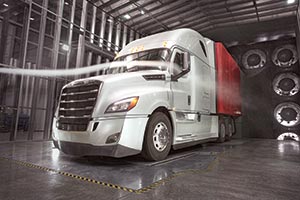Freightliner Updates Cascadia; Boosts Connectivity, Efficiency

This story appears in the Sept. 12 print edition of Transport Topics.
COLORADO SPRINGS, Colo. — Freightliner Trucks unveiled its new Cascadia model that executives said features major advancements in connectivity and fuel efficiency over the current version.
While the Cascadia name is not new, Freightliner spent much of the unveiling event Aug. 31 to Sept. 1 touting the ways the new model is a far different truck, including up to 8% more fuel-efficient.
“We just launched something that will change the industry forever,” said Martin Daum, president of Freightliner parent Daimler Trucks North America. The combo of the hardware of the truck, Daimler’s connectivity team and its partnership with Zonar means “no one is better equipped than us,” he said.
“With the new Cascadia, we have not just updated past successes. Every aspect of the truck has been reimagined,“ added Richard Howard, DTNA senior vice president of sales and marketing. “We are raising fuel efficiency, connectivity, safety, quality and uptime performance to even greater levels and also introducing a premium driver experience as a powerful customer benefit and driver retention tool.”
The 2018 Cascadia will begin to hit the road in April.
About three of every four new heavy-duty trucks sold by Freightliner are Cascadia or Cascadia Evolution models. Through July, Freightliner led U.S. Class 8 retail sales with 46,971 vehicles, and market share with 39.7%, according to data compiled by WardsAuto.com.
Company executives said aerodynamic gains on the new Cascadia come from a sloped hood and a bumper with integrated air deflector to minimize drag. A new AeroX package offers additional benefits such as longer side extenders, lower chassis fairings, drive wheel covers and proprietary wheel fairings.
The company also introduced on Sept. 1, Detroit Connect Analytics, which is available through the new connectivity platform on the Cascadia. It will provide fleets with information to identify behaviors, trends and insights on fuel consumption and safety performance. Fleet managers can view the data for a single trip, single vehicle or their entire fleet over different periods of time.
Daum called connectivity “a new land we are just starting conquer.”
To have a “meaningful impact on the performance of either drivers or the vehicle, you need to be able to see everything and be able to consume that in a way in which you or I can understand it. Detroit Connect Analytics is our move in that direction,” said Matt Pfaffenbach, DTNA’s director of connectivity.
Connected vehicles will continue to “change the life of trucking,” Daum added.
Also offered with the new Cascadia is the Detroit Assurance 4.0 system with active brake assist that provides full braking on stationary objects, adaptive cruise control and lane departure warning. There also is a warning should a pedestrian be detected by the system’s radar.
In addition, Detroit’s over-the-air capabilities, allowing customers the ability to perform remote engine parameter and other updates, will be available during the second half of 2017, the company said.
Scott Kuebler, general manager of component sales, said about 50% of Freightliner Trucks currently are ordered with optional safety technologies — and about half of those orders are for the Detroit system.
Meanwhile, there has been an overhaul of the interior for the Cascadia, starting with a centrally located hub where nearly all electronic control units are stored for easy access with no tools needed.
A new steering wheel includes one-touch buttons for key functions such as real-time miles per gallon and other key indicators such as diesel exhaust fluid levels. It is complemented by a revamped dashboard and instrument cluster designed to provide drivers with easier-to-understand information to reduce distractions.
When not on the road, an updated driver’s loft area in sleeper models has new features such as dimming lights.
While showing the new Cascadia, Toby Faulkner, director of development, highlighted smaller updates, including a third cup holder and additional storage cabinets.
Before its unveiling Sept. 1, a preview of the Cascadia was made available the night before to a dozen large-fleet customers who have spent a combined $9 billion over the past six years, the company said. Officials with several of those companies who attended the unveiling said they suggested improvements to Freightliner and credited the truck maker for carrying out the ideas, particularly improvements to the electrical system.
Fleets “were not shy about giving feedback when we got it right and when we got it wrong,” Faulkner said.
The new Cascadia is available with the integrated Detroit powertrain, which combines the 400 horsepower and 1,750 pound-feet of torque of the Detroit DD15 or Detroit DD13 engine with the Detroit DT12 automated manual transmission and Detroit steer and rear tandem axles.
“By combining advanced aerodynamics of the new Cascadia with the power of the high- performance, high-efficiency integrated Detroit Powertrain, we will help customers get the most out of every gallon,” Howard said. “We have provided an optimized, one-stop fuel-efficiency solution.”
Daum said the current model Cascadia will be produced for at least two more years. The new one will be built in Mexico and Cleveland, North Carolina.

